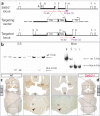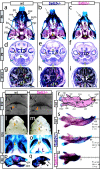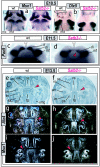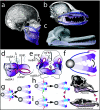Satb2 haploinsufficiency phenocopies 2q32-q33 deletions, whereas loss suggests a fundamental role in the coordination of jaw development
- PMID: 16960803
- PMCID: PMC1592575
- DOI: 10.1086/508214
Satb2 haploinsufficiency phenocopies 2q32-q33 deletions, whereas loss suggests a fundamental role in the coordination of jaw development
Abstract
The recent identification of SATB2 as a candidate gene responsible for the craniofacial dysmorphologies associated with deletions and translocations at 2q32-q33, one of only three regions of the genome for which haploinsufficiency has been significantly associated with isolated cleft palate, led us to investigate the in vivo functions of murine Satb2. We find that, similar to the way in which SATB2 is perceived to act in humans, craniofacial defects due to haploinsufficiency of Satb2, including cleft palate (in approximately 25% of cases), phenocopy those seen with 2q32-q33 deletions and translocations in humans. Full functional loss of Satb2 results in amplification of these defects and leads both to increased apoptosis in the craniofacial mesenchyme where Satb2 is usually expressed and to changes in the pattern of expression of three genes implicated in the regulation of craniofacial development in humans and mice: Pax9, Alx4, and Msx1. The Satb2-dosage sensitivity in craniofacial development is conspicuous--along with its control of cell survival, pattern of expression, and reversible functional modification by SUMOylation, it suggests that Satb2/SATB2 function in craniofacial development may prove to be more profound than has been anticipated previously. Because jaw development is Satb2-dosage sensitive, the regulators of Satb2 expression and posttranslational modification become of critical importance both ontogenetically and evolutionarily, especially since such regulators plausibly play undetected roles in jaw and palate development and in the etiology of craniofacial malformations.
Figures






Similar articles
-
Identification of SATB2 as the cleft palate gene on 2q32-q33.Hum Mol Genet. 2003 Oct 1;12(19):2491-501. doi: 10.1093/hmg/ddg248. Epub 2003 Jul 29. Hum Mol Genet. 2003. PMID: 12915443
-
Effects of phenytoin on Satb2 and Hoxa2 gene expressions in mouse embryonic craniofacial tissue.Biochem Cell Biol. 2010 Aug;88(4):731-5. doi: 10.1139/O10-013. Biochem Cell Biol. 2010. PMID: 20651846
-
Further supporting evidence for the SATB2-associated syndrome found through whole exome sequencing.Am J Med Genet A. 2015 May;167A(5):1026-32. doi: 10.1002/ajmg.a.36849. Am J Med Genet A. 2015. PMID: 25885067
-
Progress of epigenetic modification of SATB2 gene in the pathogenesis of non-syndromic cleft lip and palate.Asian J Surg. 2024 Jan;47(1):72-76. doi: 10.1016/j.asjsur.2023.09.113. Epub 2023 Oct 16. Asian J Surg. 2024. PMID: 37852859 Review.
-
SATB2-associated syndrome: Mechanisms, phenotype, and practical recommendations.Am J Med Genet A. 2017 Feb;173(2):327-337. doi: 10.1002/ajmg.a.38022. Epub 2016 Oct 24. Am J Med Genet A. 2017. PMID: 27774744 Free PMC article. Review.
Cited by
-
Special AT-rich sequence-binding protein 2 (Satb2) synergizes with Bmp9 and is essential for osteo/odontogenic differentiation of mouse incisor mesenchymal stem cells.Cell Prolif. 2021 Apr;54(4):e13016. doi: 10.1111/cpr.13016. Epub 2021 Mar 4. Cell Prolif. 2021. PMID: 33660290 Free PMC article.
-
Cryopreservation process alters the expression of genes involved in pathways associated with the fertility of bull spermatozoa.Front Genet. 2022 Oct 25;13:1025004. doi: 10.3389/fgene.2022.1025004. eCollection 2022. Front Genet. 2022. PMID: 36386822 Free PMC article.
-
Bmp and Shh signaling mediate the expression of satb2 in the pharyngeal arches.PLoS One. 2013;8(3):e59533. doi: 10.1371/journal.pone.0059533. Epub 2013 Mar 21. PLoS One. 2013. PMID: 23555697 Free PMC article.
-
Current knowledge of tooth development: patterning and mineralization of the murine dentition.J Anat. 2009 Apr;214(4):502-15. doi: 10.1111/j.1469-7580.2008.01014.x. J Anat. 2009. PMID: 19422427 Free PMC article. Review.
-
Osteoblast-specific transcription factor Osterix (Osx) is an upstream regulator of Satb2 during bone formation.J Biol Chem. 2011 Sep 23;286(38):32995-3002. doi: 10.1074/jbc.M111.244236. Epub 2011 Aug 2. J Biol Chem. 2011. PMID: 21828043 Free PMC article.
References
Web Resource
-
- Online Mendelian Inheritance in Man (OMIM), http://www.ncbi.nlm.nih.gov/Omim/ (for CPI, MSX1, PAS9, TBX1, SATB2, Alx4, Dlx5, Pitx1, Prx2, Barx1, dHand, and Hoxa2)
References
-
- Depew MJ, Tucker AS, Sharpe PT (2002) Craniofacial development. In: Rossant J, Tam PPL (eds) Mouse development: patterning, morphogenesis, and organogenesis. Academic Press, San Diego, pp 421–498
Publication types
MeSH terms
Substances
Grants and funding
LinkOut - more resources
Full Text Sources
Medical
Molecular Biology Databases

